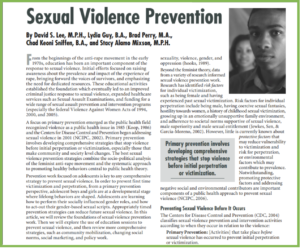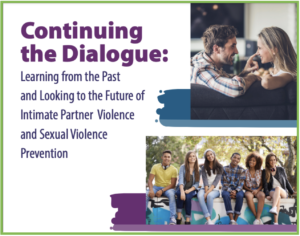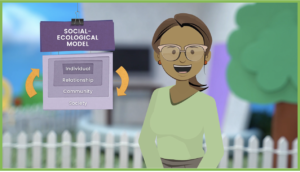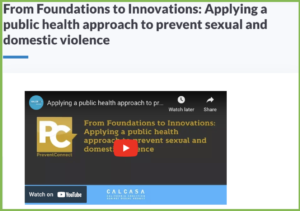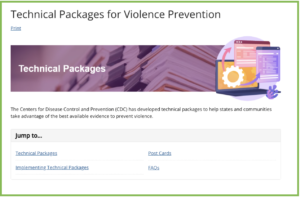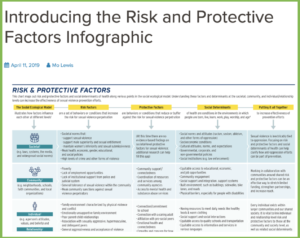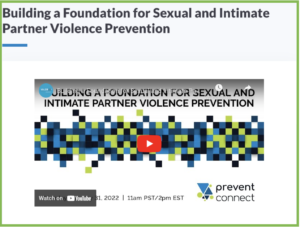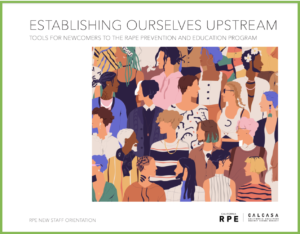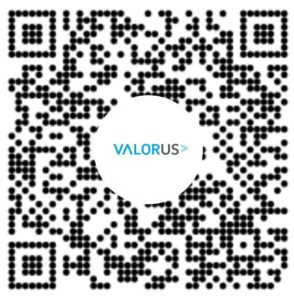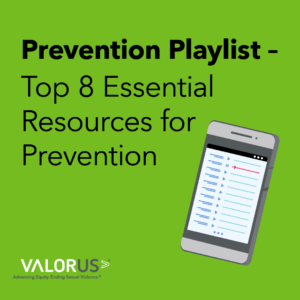
The field of preventing gender-based violence is continuously making strides in new preventative research and can be filled with jargon, acronyms, and technical language. Whether you are a veteran preventionist or are just starting, refreshing your knowledge of prevention basics is a necessary practice. Our “Top 8 Essential Resources for Prevention” helps all preventionists navigate complexities in the field, get back to basics, and introduce new resources.
1. Sexual Violence Prevention in The Prevention Researcher
The article, “Sexual Violence Prevention,” by David S. Lee and other preventionists, discusses foundational insights into the field while covering the fundamentals and spectrum of preventing sexual violence. The article provides several evidence-based strategies, such as the MyStrength Campaign which is meant to engage men and boys in violence prevention.
2. CDC’s Continuing the Dialogue
The Centers for Disease Control and Prevention’s (CDC) “Continuing the Dialogue” is a useful resource for preventionists and others who are working within the intersections of sexual assault, domestic violence, and other movements aimed at ending oppression and advocating for equity in their communities. This resource provides an easy-to-digest, accessible explanation of the public health approach to violence prevention.
3. CDC’s Principles of Prevention from VetoViolence eLearning module
The CDC’s VetoViolence training is an animated e-learning module that discusses the Principles of Prevention (POP), the definition of violence, and the impacts that violence has on a national level. The engaging training includes units that cover the public health approach to violence prevention, identifies the four levels of the Social Ecological Model, and explains the distinctions between primary, secondary, and tertiary levels of prevention. It also provides examples and training on implementing prevention at the individual, relationship, community, and societal levels to create sustainable, healthy, safe, and thriving communities free from violence.
PreventConnect’s web conference “From Foundations to Innovations” highlights the fundamentals of the public health approach to preventing sexual and domestic violence. The web conference brings attention to emerging themes in the prevention field while introducing the THRIVE framework to help identify underlying contributors to interpersonal violence and how to use the Spectrum of Prevention to create comprehensive prevention strategies.
5. CDC’s Technical Packages for Violence Prevention
The CDC has developed technical packages to help states, organizations, and communities implement evidence-based strategies to prevent violence. The technical packages provide implementation prevention curricula for sustainable reductions of specific risk factors for Adverse Childhood Experiences (ACEs), Child Abuse and Neglect, IPV, SV, Youth Violence, and Suicide.
6. NSVRC’s Risk and Protective Factors Infographic
The National Sexual Violence Resource Center’s (NSVRC) “Risk and Protective Factors” infographic helps explain different social elements that impact the likelihood of sexual violence occurring. The graphic breaks down prevention within the social-ecological model while discussing how to increase the effectiveness of the efforts.
7. NSVRC’s Prevention 101 Bootcamp
NSVRC’s “Prevention 101 Bootcamp” includes in-depth e-modules on the fundamentals of prevention, advocacy, and self-care in the sexual violence prevention field. Take your time as you work through these self-paced modules.
PreventConnect’s “Building a Foundation for Sexual and Intimate Partner Violence Prevention” web conference provides a basis for understanding the importance of primary prevention. The web conference highlights real-world examples and shares resources to help expand knowledge on prevention strategies.
Here are two bonus resources for California RPE programs. Check them out:
1. Establishing Ourselves Upstream Toolkit
The Rape Prevention Education (RPE) onboarding toolkit, created in 2021, is a comprehensive guide for RPE grantees who are new hires. This toolkit includes a new staff checklist, VALOR and CDPH roles, an overview of California’s RPE program, tier 1 (Close to Home) and tier 2 (school-based) programs, and a “Deep Dive” section that features numerous resources and reading to get started in prevention.
The Learning Center is an online resource center that includes courses, past web conferences, and resources related to prevention and other topics related to ending gender-based violence. Create a free account today!
Be sure to stay connected through the VALOR and PreventConnect newsletters!


